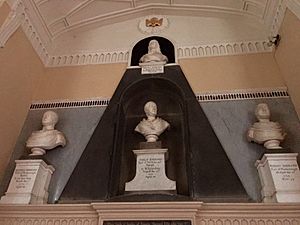Philip Sherard, 2nd Earl of Harborough facts for kids
Quick facts for kids
The Earl of Harborough
|
|
|---|---|

Portrait of Lord Harborough by Frans van Stampart
|
|
| Member of Parliament for Rutland | |
| In office 1708–1710 |
|
| Preceded by | Richard Halford Sir Thomas Mackworth |
| Succeeded by | Lord Finch John Noel |
| Personal details | |
| Born |
Philip Sherard
c. 1680 |
| Died | 20 July 1750 (aged 69–70) Stapleford, Leicestershire |
| Spouses |
Anne Pedley
(after 1703) |
| Relations | Robert Sherard, 4th Earl of Harborough (grandson) |
| Children | 14 |
| Parents | Bennet Sherard Dorothy Fairfax Stapylton |
Philip Sherard, 2nd Earl of Harborough (born around 1680 – died July 20, 1750), was an important British landowner and politician. He lived in Whissendine, Rutland. He was a member of the Whig political party. He served in the House of Commons (like today's Parliament) from 1708 to 1710. Later, he inherited the noble title of Earl of Harborough.
Contents
Early Life and Family
Philip Sherard was the oldest son of Bennet Sherard. His mother was Dorothy Fairfax. She was the daughter of Henry Fairfax, 4th Lord Fairfax of Cameron.
Philip inherited his father's estates when his father passed away in 1701.
Political Career
Philip Sherard began his public service in 1705. He was appointed a Gentleman of the Privy Chamber to Queen Anne. This was an important role in the royal household.
Serving in Parliament
In 1708, Philip Sherard was elected as a Member of Parliament (MP). He represented the area of Rutland. He was part of the Whig party.
As an MP, he voted on important issues. For example, in 1709, he supported a law to allow people from Palatine (a region in Germany) to become British citizens. In 1710, he voted to impeach Dr. Sacheverell. Impeachment is a process to accuse a public official of wrongdoing.
He tried to get re-elected in 1710 but was not successful.
Later Appointments
In 1714, his role as Gentleman of the Privy Chamber was renewed. This time, it was for the lifetime of King George I.
In 1715, he became a deputy lieutenant for Rutland. This role helped him manage local affairs. He tried to win back his seat in Parliament in 1722 but was defeated again.
Becoming an Earl
On October 16, 1732, Philip Sherard inherited a noble title. He became the 2nd Earl of Harborough. He inherited this title from his cousin, Bennet Sherard, 1st Earl of Harborough.
After becoming an Earl, he received more important positions. In 1733, he was appointed Lord Lieutenant of Rutland. This was a high-ranking official role in the county. In 1744, he also became a deputy lieutenant of Lincolnshire.
Family Life

On March 12, 1703, Philip Sherard married Anne Pedley. She was the daughter of Nicholas Pedley.
Philip and Anne had a large family. They had six sons and eight daughters. Some of their children included:
- Bennet Sherard, 3rd Earl of Harborough (1709–1770): He became the 3rd Earl after his father. He married four times.
- Hon. John Sherard (died 1746): He was a lawyer and served in the Yeomen of the Guard. He never married.
- Rev. Robert Sherard, 4th Earl of Harborough (1719–1799): He became the 4th Earl. He married three times and had children.
- Hon. Daniel Sherard (1722–1744): He was a Lieutenant in the Royal Navy.
- Hon. Philip Sherard (1726/7–1790): He was a Lieutenant-General in the British Army. He fought in the Seven Years' War. He never married.
- Lady Dorothy Sherard: She married Rev. James Torkington and had children.
- Lady Lucy Sherard (died 1781): She never married.
- Lady Susan Sherard (died 1765): She never married.
- Lady Ursula Sherard (died 1745): She never married.
Lord Harborough passed away on July 20, 1750, in Stapleford, Leicestershire. He was buried near Whissendine. His son, Bennet Sherard, became the 3rd Earl of Harborough.

